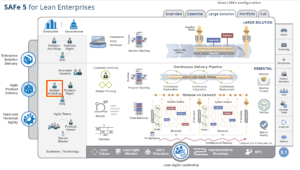In the world of agile software development, the role of a Scrum Master is crucial to the success of a Sprint. However, certain pitfalls, known as“anti-patterns“, can sometimes get in the way. An anti-pattern is a frequently-used solution to a recurring problem that often proves ineffective and potentially very counter-productive.
In this article, we’ll explore five typical anti-patterns that a Scrum Master might encounter during a Sprint, and propose solutions to prevent these behaviors, with the aim of maintaining optimal team productivity.

Index
Anti-pattern: Scrum team independence compromised
Finding:
In some cases, the Scrum Master may “pamper” his team too much, making them dependent on his services (organizing and running meetings, taking notes, updating Jira, etc.).
Solution:
To solve this problem, the Scrum Master must encourage the team to take an active part in these tasks. The key is to encourageself-management, an essential component of Scrum, while remaining available to support and guide the team if necessary.

Anti-pattern: Workflow disruption
Finding:
A common anti-pattern is when the Scrum Master allows Stakeholders to disrupt the development team’s workflow during the Sprint. This can happen in many ways, such as when the Scrum Master doesn’t intervene when management invites developers to random meetings, or allows stakeholders to turn the Daily Scrum into a reporting session.
Solution:
The Scrum Master must assume his role as protector of the team’s workflow. It’s important to establish clear boundaries and ensure that the Daily Scrum remains focused on progress towards the Sprint objectives.

Anti-pattern: Lack of support
Finding:
A Scrum Master can sometimes neglect to actively support team members who need it, an anti-pattern that can hinder project progress.
Solution:
The Scrum Master must cultivate a proactive posture to offer help, remaining alert to potential difficulties and offering to help even when help is not explicitly requested. It is the Scrum Master’s facilitation posture that must not be overlooked!

Anti-pattern: Tolerance of micro-management
Finding:
A Scrum Master must prevent the Product Owner or any other person (Manager, Stakeholder…) from assigning tasks to developers, as this goes against the self-organization of the development team. Tolerating this type of micro-management is another anti-pattern that can be detrimental to team effectiveness.
Solution:
The Scrum Master must ensure that the team’s self-organization is respected, intervening if necessary to remind everyone that developers are responsible for managing their own tasks. The Scrum Master is the guarantor of the proper application of Scrum within his team. He must use his Scrum team protector hat.
Here is an excerpt from the Scrum Guide addressing this particular issue:
During the sprint:
- The sprint objective is fixed, so changes that call it into question are not allowed.
- Quality targets are maintained; they are never lowered; and
- The scope can be clarified and renegotiated between the Product Owner and the Development Team according to what the Scrum Team learns.
Anti-pattern: Ineffectiveness of the Sprint retrospective
Finding:
The last common anti-pattern is the avoidance of conflicts and problems during Sprint retrospectives. Ignoring these issues or sweeping them under the carpet can often indicate a capitulation to organizational demands that run counter to Scrum’s values and principles.
Solution:
The Scrum Master should use Sprint retrospectives as an opportunity to openly address problems and conflicts, and to promote a culture of transparency and continuous improvement.

For further reading: reading tips
To deepen your knowledge, I recommend you read the Scrum Guide in its most recent version (2020), available free of charge on the official website.
Another excellent book that I often recommend to Scrum Masters for an in-depth understanding of the Scrum Framework is :
Scrum, from theory to practice(Lien Fnac | Lien Amazon)








